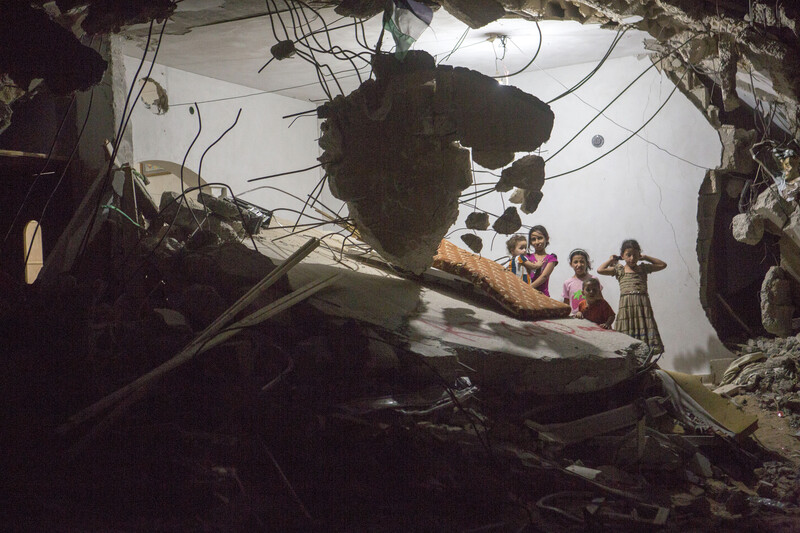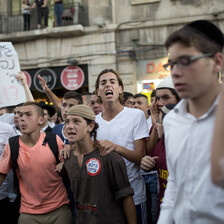The Electronic Intifada 10 July 2015

A destroyed home in Khuzaa, September 2014.
ActiveStillsSpending the day of 17 August in Khuzaa was like peering through a window to hell. But what we witnessed in the landscape of apocalyptic oblivion paled in comparison to the experience described to me by two Palestine Red Crescent volunteers who had attempted to break through the Israeli military cordon during the siege of the town.
Twenty-five-year-old Ahmed Awad and 24-year-old Ala’a Alkusofi arrived at the edge of Khuzaa at a time when Red Cross ambulance crews refused to travel anywhere near the town. They said they had come to collect the body of a man whom soldiers had lashed to a tree by both arms and shot in the leg. When they arrived at the site, the soldiers ordered the driver of their ambulance, Muhammed Abadla, to exit the vehicle. When he obliged, they told him to walk five meters forward and switch on a flashlight. As soon as he flicked the light on, the soldiers shot him in the chest and killed him.
“It was something I’ll never forget,” Awad recalled, “seeing a colleague killed like that in front of me. I couldn’t believe what I witnessed.”
The two Red Crescent volunteers told me they later found a man in Khuzaa with rigor mortis, holding both hands over his head in surrender, his body filled with bullets. Deeper in the town, they discovered an entire family so badly decomposed they had to be shoveled with a bulldozer into a mass grave. In a field on the other side of town, Awad and Alkusofi found a shell-shocked woman at least 80 years of age hiding in a chicken coop. She had taken shelter there for nine days during the siege, living off of nothing but chicken feed and rain water. “She couldn’t believe it when we found her,” said Alkusofi. “She was sure she would die with the chickens.”
Horror stories
In nearly every shattered home I entered in Khuzaa, on every bomb-cratered street, in destroyed mosques and vandalized schools, I heard horror stories like this. Every resident I met in this town was touched by the violence in one way or another. While visiting the town, I wandered into the courtyard of a rehabilitation clinic for women and children afflicted with Continuous Traumatic Stress Disorder — a condition that affects a solid majority of youth in Gaza.
Located on a street lined with four-story apartments pockmarked with bullets and tank shells, the school was completely empty, but the signs of an Israeli presence were everywhere. As we entered, we found Stars of David spray painted by soldiers across the walls, right below colorful heart-shaped paper cut-outs bearing the names of students. In the closet of an administrative office that was neatly kept except for a few scattered papers, I found a spent M72 Light Anti-Tank Weapon. It was one of the shoulder-mounted launching tubes manufactured in Mesa, Arizona, by the Norwegian-owned Nammo arms corporation. The weapon had been used by the Israelis to rocket civilian homes across Gaza’s boundary regions.
In a classroom across the courtyard, sunrays burst through a gaping hole in the wall about the size of a 120mm tank shell. They shone light on a series of colorful posters decorated with matching ribbons that contained motivational messages. They read:
It always seems impossible until it’s done
Stay alive
Look to the future
No negative thoughts allowed
We wandered around the corner, past a group of children filling a jug of water from a truck that replaced the water tower Israeli forces detonated, past the giant dome of the Ebad al-Rahman mosque, which now sat on a pile of rubble next to the toppled water tower like the ancient ruins of some bygone empire. Nearby, we entered a small courtyard surrounded by a warren of shattered homes. At the edge of the yard, a small boy lay impassively in his bed in a room with no walls. A ceiling fan that looked as though it had been melted dangled above his head. In the center of the yard sat a gigantic olive green barrel. It was a spent Giant Viper round — one of the C4-packed mine clearing devices the Israelis fired into the center of Khuzaa during the assault on the town. A hen flapped its wings next to the barrel and chased after baby chicks bouncing through the rubble.
“Where are you from?” an old man called out to me from the road. He wore large spectacles and a morning robe, his front pocket stuffed with paper notepads, various cards and a glasses holder. He reminded me of my older Jewish relatives who came of age before the digital era and grew accustomed to carrying stacks of business cards, coupons and handwritten reminders in their shirt and coat pockets along with assorted mints and pens.
“I’m from America,” I told the man, readying for an indignant response.
“Ahhhh, Amreeka,” he grumbled. “I want to thank the American people,” the man continued, advancing to within two feet of me. “They are nice people, they give us food and bread and they give the Israelis weapons to kill us. They have different standards. It would be nice if they treated us all as humans.”
“We love life”
He introduced himself as Ali Ahmed Qudeh, the father of Kamal Qudeh, the doctor who treated the town’s wounded under heavy bombardment and in spite of being injured himself. Like his son, Ali Ahmed was a supporter of Fatah, the rivals of Hamas. And like virtually everyone I met in Gaza, he was an ardent supporter of the armed resistance of the Qassam Brigades, Hamas’ armed wing. “Our weapons are not terrorist weapons, our weapons are [for] self-defense,” he insisted. “Our weapons are to free our land. We are dignified people, we love life. We don’t hate life like they say. But we’ll die for our land.”
As a group of small children gathered in the courtyard, Ali Ahmed detailed to me how many family members each child lost in the assault on Khuzaa. Pointing at the little boy lying in bed, he suggested that the most devastating consequence of the war was not the death toll, but the psychological impact on the youngest members of his community.
“That kid wants to make an atomic bomb and obliterate Israel!” he roared. “Why? Because he saw his family members die in front of him! How can you raise kids who want to make bombs?”
When I made my way back into the road, I heard Ali Ahmed call after me again. He was rushing forward through the rubble with a tray of sweets. “I don’t mean to say that all Americans are bad,” he said, urging me to take a freshly baked cookie. “It’s the government that’s the problem, not the people.”
Just then, an Israeli squadron of American-made F-16s roared through the sky. A small girl standing beside me ducked reflexively at the sound of the jets, bracing for another missile strike. The war was far from over.
This essay is excerpted from Max Blumenthal’s new book, The 51 Day War: Ruin and Resistance in Gaza published by Nation Books.
Max Blumenthal is an award winning journalist and bestselling author. His previous books include Goliath: Life and Loathing in Greater Israel (2013, Nation Books).





